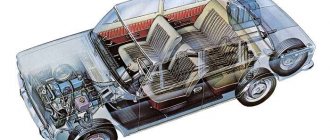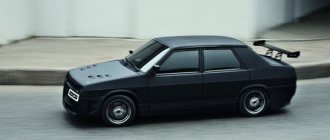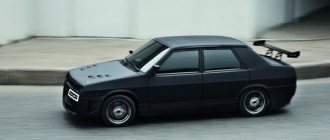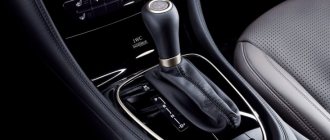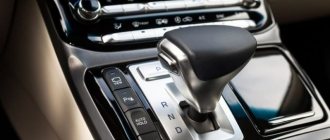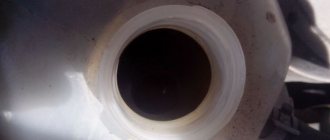VAZ-21099 Samara/Sputnik is the first front-wheel drive sedan produced by the Volzhsky Automobile Plant. Production of car 21099 began in 1990. The ninety-ninth is, by and large, a “nine” with a body that has four doors. The ninety-ninth was the final one in the Samara family. This model differs from its older sisters in the increased length of the body due to the overhang of the luggage compartment. This model has an original radiator grille, the front fenders and hood were made without a plastic mask. The panel (dashboard) also underwent changes, it became “high”. In the future, these improvements were applied to all cars of the Samara family. 21099 was most popular before the release of the LADA 110. The ninety-ninth had high speed characteristics and good handling on various sections of the road.
Short wing, index 2110 and design from Fiat: myths and facts about the VAZ-21099
The VAZ-21099 sedan appeared last in the “eighth” family, passing forward onto the assembly line not only the three-door hatchback of the eighth model, but also the five-door “nine”. This peculiar “marketing miscalculation” of the Togliatti leadership, oddly enough, had only a positive effect on the “ninety-ninth”, making this model not only the most long-awaited among the other Sputniks, but also one of the most prestigious VAZ models in the early nineties! In addition, unlike other “chisels”, it is not as widespread – at least at first. That is why the most incredible and contradictory rumors circulated about the sedan. Today we will understand the folk “myth-making” associated with one of the most desirable front-wheel drive cars with a rook on the grill.
“Ninety-nine” appeared on the roads of the USSR in the first half of the nineties, appearing on the cover of the magazine “Behind the Wheel” back in 1990.
The front-wheel drive sedan appeared in the Za Rulem magazine back in early 1989, and appeared on the cover twice - in 1990 and 1992. Each publication on the “ninety-ninth” caused a huge stir among Soviet motorists
A rather long “road to the assembly line” served as a reason for accusing the new product (and Tolyatti designers) of plagiarism. After all, back in the late eighties, used foreign cars poured into the Soviet Union in a stormy stream, including those of the Fiat brand. Soviet citizens, taught by the experience of many years of queues and total shortages, “took everything from life,” sweeping away even such used exotics as Trabants and Wartburgs abroad. So it turned out that even before the release of serial and commercial vehicles of the ninety-ninth model, the sedan was “condemned” in absentia, having been recorded as an unlicensed copy of the Fiat Regata. This car was produced by the Italian concern from 1983 to 1990 - that is, the Regatta was just taken out of production at a time when the “zero-nine-nine” was just entering the assembly line.
Fiat Regata – similar dimensions, same front-wheel drive and sedan body.
Unlike Samara, Regata was also offered with a station wagon body
However, in reality, work on a sedan based on the 2108/2109 hatchbacks began back in 1980 - it was then that VAZ designer Vladislav Pashko began creating a four-door, three-volume vehicle. One of the main criteria of the project was its maximum unification with the future “nine”. That is why the cars are practically the same right up to the rear wings. The rear part, of course, received a different design: instead of a lifting fifth door, an L-shaped trunk lid opening at an angle of 80 degrees appeared, and the angle of the fixed rear window changed.
Thanks to the protruding trunk, both the proportions of the Sputnik body and its silhouette have changed
The main (and only) difference between the VAZ-21099 and the “nine” begins behind the second pair of doors
At the same time, the trunk line became much higher than on previous sedans, which was an innovation not only in the Soviet automotive industry, but also in global practice. After all, cars with such a tailgate solution were just starting to be produced (confirmation of this is the Volkswagen Jetta MKII, Ford Orion, Opel Kadett E, and so on).
No worse than others: a high and relatively short trunk at that time appeared on sedans from Ford, Opel, Volkswagen and many other European brands
The full-size model of the future "ninety-nine" was ready at the end of 1981. It differed from the production car only in the design of the front part of the body, and in addition to the standard “short-winged muzzle” for the VAZ-2108 with a grille in the form of a protruding “beak”, the sedan prototype also tried on four round headlights in the “six” style, which, according to the idea, This car was supposed to replace its creators, becoming the most prestigious and expensive VAZ car of the new decade.
Exploratory version of the front end: on one side – a regular headlight and a “short wing”, on the other – two round ones and a “long” one
Subsequently, Pashko abandoned both the “mask with a beak” and the round headlights in favor of the usual “eighth” optics and a “long wing” that reached the direction indicators. The VAZ-21099 has similarities with the Italian car, but there is no reason to talk about direct plagiarism, because the layout was made before the production Regata appeared. It is obvious that the designers of the Volzhsky Automobile Plant thoughtfully analyzed the experience of their colleagues in the workshop (including those from Fiat), but the Fiat three-box not only has a completely different “expression” of its face, but also other solutions - in particular, “straight” rear arches and a window in rear door instead of a small “third” window in the rear roof pillars.
Hello from the Soviet past: a piece of paper indicating the body color is pasted on the trunk lid.
Hello from the Soviet past: a piece of paper indicating the body color is pasted on the trunk lid. Hello from the Soviet past: a piece of paper indicating the body color is pasted on the trunk lid.
In general, the car was more pleasing than disappointing. I roared the muffler moderately, the CV joints did not crunch when turning. I got the impression that the previous two owners treated it with great love and the mileage of more than 97,000 km is honest. Considering that the car is supposed to run about 150,000 km before its first capital, this one will still serve. So if you find a similar option, you can safely buy it for everyday trips.
In everyday life, the 99 is unpretentious, its appetite is modest, and the horsepower tax is simply ridiculous. The driving qualities are also excellent, it’s not for nothing that the German company took part in the development of the first front-wheel drive family of VAZs. If you are over forty, this car is perfect for relieving mild nostalgia. If you are young, then, owning such a device, you will understand why the 99th for your parents personified the concept of “life is good.” Sophisticated smartphones or tablets are valued in much the same way today in society.
By the way, this car also has a computer. It is, of course, non-standard, but nevertheless shows all the necessary parameters. We never even dreamed of this at the time.
VAZ 21099
VAZ-21099 Samara/Sputnik is the first front-wheel drive sedan produced by the Volzhsky Automobile Plant. Production of car 21099 began in 1990. The ninety-ninth is, by and large, a “nine” with a body that has four doors. The ninety-ninth was the final one in the Samara family. This model differs from its older sisters in the increased length of the body due to the overhang of the luggage compartment. This model has an original radiator grille, the front fenders and hood were made without a plastic mask. The panel (dashboard) also underwent changes, it became “high”. In the future, these improvements were applied to all cars of the Samara family. 21099 was most popular before the release of the LADA 110. The ninety-ninth had high speed characteristics and good handling on various sections of the road.
Trial
Nothing extra
These two cars look quite attractive. Their design is devoid of provocative solutions, but it is harmonious and thoughtful. “Nine” has a more rapid body profile, while 21099 is more sedate and respectable.
In terms of geometric cross-country ability, the 2109 has a slight advantage due to shorter body overhangs. But driving over potholes on the 21099 is more problematic due to the long stern.
Comfortable and cozy
The interior of both Samaras is identical. It is worth mentioning in advance that the quality of finishing materials is far from ideal - hard, echoing plastic everywhere. Of course, plastic made it possible to reduce the weight of cars, but it deprived VAZ models of that touch of luxury for which the Zhiguli of the classic family is famous. At the same time, the ergonomics are good and you don’t have to be distracted from the road thanks to the compact layout of the controls.
Elastic front seats provide good body support. However, a tall driver will complain about the lack of adjustment of his seat in the longitudinal plane. Only two passengers are comfortable on the back seat, provided their height is less than 175 centimeters.
As for the luggage compartment, there are differences between 2109 and 21099. The “Nine” has a trunk volume of 270 liters, while its more practical companion platform has this figure already equal to 400 liters.
Specifications
VAZ 21099 is a sedan with front-wheel drive, a 1.5-liter gasoline engine and a five-speed gearbox. The 21099i model has a 1.5 engine with distributed fuel injection (injector) that complies with international exhaust gas standards. Just like the Lada Kalina car. The car is equipped with a panel that includes several instruments. Illuminated switches for electronic control of windows and door locks. The on-board monitoring system notifies the driver of a vehicle malfunction. A tilt steering column is also installed. Comfortable seating for the passenger and driver will be ensured by new seat filling material and height adjustment of the seat belt. Installed fog lights improve the light characteristics of the car.
The ninety-ninth retains dignity regardless of external circumstances. In response to stricter global environmental requirements, and in an effort to increase comfort for customers, the plant decided to install a more economical engine with distributed fuel injection that meets global standards. Subsequently, like the Chevrolet Niva, which has recently conquered the Russian auto industry.
From the beginning of production and throughout it, models were produced with injection and carburetor engines of 1.3 liters (210993) and 1.5 liters (21099). There are the following modifications for the ninety-ninth with carburetor engines: VAZ 21099 - 00 - standard equipment, VAZ 210992-01 - standard equipment and VAZ-21099-02 - luxury equipment. For cars with an injector: VAZ-21099-20 - standard, VAZ 210992-21 - standard equipment, VAZ 21099-22 - luxury equipment.
Even now, the VAZ 21099 is considered one of the most popular models on the Russian market and is highly rated both with the UAZ Patriot and many other models, but for now it is the most convenient and already familiar car in Russia. Suffice it to say that you can confidently drive to your summer cottage in this city sedan. Since the launch of the car, its price has been high for the domestic automobile market. The price of the VAZ-21099 car indicates that the car was not produced for transporting goods to markets. But for people who are not rich (middle class) who were affected by the crisis, a car is an option. The appearance of the car is quite representative and even universal. The rear seat reclines, but not completely. Despite this, the car allows you to transport long objects. The interior trim is not poorly made and does not scare away current buyers.
Export Samaras available on the automobile market must be equipped with an exhaust gas catalyst. Installation, which has been underway since 1993. Of all existing engine versions, the 70-horsepower standard carburetor with a volume of 1.5 liters would be preferable. But, despite this, the VAZ 2108 and 2109 with a carburetor engine capacity of 1.3 and a power of 64 horsepower are very popular. The only significant drawback of this modification is the bending of the valves when the timing belt breaks.
Car VAZ 21099 photo:
[ngg_images source=»galleries» container_ids=»1" display_type=»photocrati-nextgen_basic_thumbnails» override_thumbnail_settings=»0" thumbnail_width=»240" thumbnail_height=»160" thumbnail_crop=»1" images_per_page=»20" number_of_columns=»0" ajax_pagination =»0" show_all_in_lightbox=»0" use_imagebrowser_effect=»0" show_slideshow_link=»1" slideshow_link_text=»[Show slideshow]» order_by=»sortorder» order_direction=»ASC» returns=»included» maximum_entity_count=»500″]
FINPLAN
The price range is from 30,000 rubles for outright rubbish to 250,000 for cars of the last years of production in the original and without any hint of tuning. By the way, about fine-tuning: it was the first wave of domestic front-wheel drive that Russia owed to the flourishing production of all kinds of automotive accessories of varying degrees of usefulness. That is why such cars are now readily bought in order to turn them into sports cars.
Another secret of its popularity is the availability of spare parts, which allows you to restore an extremely shabby car for a very modest price (even compared to other state-owned vehicles). Judge for yourself: the outer side panel is 2,200 rubles, a similar part for the Nexia is 10,860. The hood for the 99th is 1,980 rubles, the owners of the Daewoo will have to shell out 8,400. Surprisingly, very large pieces of hardware often cost significantly less than you pay for their subsequent coloring. What a carburetor, buy a new assembled carburetor engine for a VAZ-21099 for 35,400 rubles!
Modifications of VAZ 21099
The technical characteristics of the various modifications are almost the same. All engine modifications have 4 cylinders, the power of the 1.3 engine is 64 hp, and the 1.6 engine is 80 hp, as you can see, the power has not been increased much relative to the engine size. All modifications are designed for AI-92 fuel. The transmission on all models is manual with a five-speed gearbox. The braking system has disc brakes at the front and drum brakes at the rear. From the factory, stamped wheels of 13 radius are installed on the ninety-ninth. As for the body, its dimensions differ slightly, the only difference is in the height of the body: on 1.3 and 1.5 the height is 1402, and on the rest 1400 centimeters. The luggage compartment is larger by 1.5 and is 480 liters; on other versions it is 420 liters. The maximum speed and acceleration time also do not have a significant difference, but fuel consumption is more economical on the latest modification with a 1.6 engine.
What is the reason for floating revolutions
Car owners often continue to operate their vehicle even if the engine is unstable while driving. However, such a malfunction can have a number of negative consequences. Firstly, floating speeds can easily lead to a traffic accident when, when coasting or changing gears, the engine stops working and the steering wheel jams. In addition, the driver must be constantly distracted in order to stabilize the speed by stepping on the gas or simply not allowing the engine to stall by keeping his foot on the gas. Secondly, fuel consumption increases significantly, and all engine operation systems operate in variable mode, which creates additional load on them. The malfunction is easily diagnosed, its elimination does not require significant investment of time and money.
Check the spark plugs first
If the coordinated operation of individual components of the power and ignition system is disrupted, various malfunctions occur that lead to engine failures. One of the first signs of a problem is high engine speeds if the injector stalls while driving. The most typical manifestation of a possible malfunction is a situation where the idle speed fluctuates. The speed can change from 500 to 2500-3000 per minute with an oscillation interval of about 1 second. In this case, the number of revolutions is periodically equalized. If the amplitude is larger, the engine will most likely stall.
Situations arise when the control unit receives incorrect information, which is why the electronics cannot make a timely decision about the command being given. If an excess amount of air enters, while the engine temperature is sufficient for normal operation, and the throttle is open in the desired mode, the control unit may not cope with the problem. When engine speeds fluctuate or are simply high, one of the possible reasons may be improper operation of the forced speed increase device. This will be the culprit for the intake of too much air.
A faulty idle speed sensor may also be responsible for floating rpm. This device ensures stable engine operation at any speed. If the sensor does not transmit the correct signal, the volume of air supplied to the cylinder will differ from the required one. In this regard, floating speed is possible not only after starting the engine, but also after it warms up.
Colors of vases 21099 by year
| Related: | VAZ-2108 VAZ-2109 |
| Segment: | B-segment |
| Load capacity: | 425 kg. |
| Fuel consumption: | 5.9-8.9 l/100 km |
| Volume of the tank: | 43 l |
VAZ-21099
- a four-door front-wheel drive sedan developed by the Volzhsky Automobile Plant. It is the most full-size model in the Lada Sputnik family.
It was serially produced at the AvtoVAZ plant from December 22, 1991 (pre-production versions were produced from 1990) to June 30, 2004. Until the end of 2011, it was assembled in Ukraine using Russian vehicle kits with an interior design similar to that of its successor model, the VAZ-2115, with only one difference (this model was produced under the brand name “ZAZ-21099”).
The VAZ-21099 was exported under the names Lada Forma, Lada Sagona, Lada Sable, Lada Samara Saloon
.
Modifications
Since the start of production, modifications with carburetor and injection engines with a working volume of 1.3 liters (VAZ-210993) and 1.5 liters (VAZ-210990) have been produced in different years. The model range of JSC AVTOVAZ includes modifications of the VAZ-21099 with carburetor and injection engines (VAZ-21099i). A version with permanent all-wheel drive (Lada-Victory) was also produced, but production was discontinued due to low sales. And the model with a turbocharged 8-cylinder engine (Lada Sport) was produced only by individual order.
Question:
Hello, dear Car Owners and Auto Mechanics. I have a problem of this nature in general terms; I bought a VAZ-21099 injector car. When I purchased the car, it was in working order, but the temperature sensor did not show and the CHECK light was on. The rest is normal. After 3 day trips to register and fill the tank with 95 and a flushing additive, the car stopped starting for 1 day. So after I looked under the hood and saw that the fastening bolt had come off the RXX, I replaced the RXX (idle air control) with a known working one and replaced the mounting bolt. She was standing in the cold, starting it up, it starts very poorly, and then with the gas pedal pressed to the floor and does not pick up speed, it holds somewhere around 500/600, and the CHECK does not light up after waiting for 40-50 seconds with the gas pedal pressed, it picks up speed, I release the pedal, it holds idle speed. I warmed up the car for about 10 minutes, then turned it off and walked away for about 5 minutes and came back again and it won’t start, even with the pedal pressed. It was decided to replace the fuel pump mesh, cut a hole, released the pressure, removed the pump and replaced the mesh with a new one, the old one was very clogged. Changed the fuel filter to no avail. Effect 0. Well, off to a tangent, I replaced (mass air flow sensor), also replaced the throttle assembly and its sensors, replaced the thermostat and temperature gauge sensor, oil pressure sensor, crankshaft position sensor, cleaned the injectors and ramp. Replaced all relays and fuses under the passenger shelf and under the hood. Replaced the spark plugs, (Everything that was changed is known to work) Tensioned the alternator belt. And this is the problem: now the car starts and after 5-20 seconds the pump stalls, pumps, The pressure in the rail after pumping up the fuel pump is 2.3, 2.2 There is a spark on all the spark plugs (the signal is fine) The exhaust is normal The marks match and where the timing belt is and where the flywheel is, The injectors are clean. What I don’t know, I don’t want to go to the service. I decided to climb and in the salon I opened the panel where the brains are (Bosch), for me there is a dark forest coming from the brains, a flagellum with contacts (Not under the shelf), apparently for adjustments there are closed 1st row 2nd contact with 2nd row 3rd contact. I didn’t understand why. I removed the jumper to no effect. I put it back. Tell me, maybe I forgot to check?
Modernization
Since 1997, the AvtoVAZ pilot production began producing the VAZ-2115 model, which was a restyled version of the VAZ-21099 and the first car of the so-called Samara-2 family.
In 2004, the VAZ-21099 was discontinued by AvtoVAZ and completely replaced by the VAZ-2115 model, after which the model was assembled in Ukraine by ZAZ CJSC. At the end of 2011, production of the VAZ-21093 (hatchback) and VAZ-21099 (sedan) was finally discontinued. [1]
LADA Vic[1]y (VAZ 21099)
— the difference from the base model was that Victory was an all-wheel drive (4x4) car. The car was made according to this principle: they took a VAZ 21099, added a transmission, in particular an angular gearbox, a viscous coupling and a rear axle gearbox from Volkswaqen Golf Syncro, and the result was a VAZ 21099 Victory.
The axle shafts remained from the base model, one transmits torque from the engine to the rear axle, and two more serve to drive the front wheels. The exterior of the Victory was distinguished by the basic modifications of the VAZ 21099 rear spoiler, the car was equipped with alloy, fourteen (14″) inch sports wheels and bright red “Victory” and “4×4” nameplates on the trunk lid.
The exhaust system was also changed on Victory, and the engine was installed with a volume of 1600 cm². Speaking about the technical characteristics of the car, we can note the good acceleration dynamics of the Victory, which is not surprising, because the engine was installed with a boost.
All-wheel drive provided the car with simply amazing maneuverability, but due to its cost, the VAZ 21099 Victory was not widely used, and production of the car was curtailed.
The car was also exported to European countries.
Basic faults
Differing from its predecessors only in body type, the VAZ 21099 inherited the malfunctions characteristic of them. However, there are also “original” damages. The most common malfunction of the VAZ 21099 car is unstable idle speed.
Periodically they begin to swim, but it is almost impossible to find any pattern. The cause of this may be the throttle position sensor. It is an ordinary potentiometer, which periodically loses contact due to constant use. Replacing the sensor will help solve the problem.
A faulty ignition module is a common problem for many owners. In this case, the machine operates unstably when driving at low speeds. It’s easier to say - it twitches. Typically this means that there is no contact within the module itself between the coil and the commutator.
Sometimes the car stops starting. The culprit may be the idle speed sensor. You can check this very simply. When starting, you need to press the gas pedal; if the engine starts, the sensor is at fault. The air flow sensor can sometimes cause a rough idle. However, do not rush and run to the store for a new one.
The fact is that, due to its design features, the sensor needs very good contact with the body. It is necessary to check whether there is mass on it. A common problem with Euro 2 engines is exhaust manifold gasket burnout. In this case, “Check-Engine” lights up on the panel.
